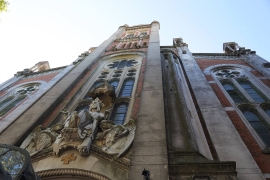If there are milestones in the Parish of San Carlos Borromeo and the Basilica of María Auxiliadora in Almagro, in the city of Buenos Aires, Argentina, the most outstanding were that, as a child, the famous Argentine tango singer Carlos Gardel sang in the choir; and that Ceferino Namuncurá made his first communion there in 1898.
However, since March 2013, there has been another milestone: on Christmas 1936, the Jorge Mario Bergoglio was baptised as a child. Today, on one of its side walls, a copy of the minutes of the parish register that records the sacrament is framed. "Jorge Mario, son of Mario Bergoglio and Regina Sívori, sponsored by Francisco Sívori and Rosa Vassallo de Bergoglio, was baptised by Salesian Father Enrique Pozzoli", we read.
In Lombard Romanesque style, the basilica project began in April 1899 when the first sketches were presented to expand the church of San Carlos, built in 1872 and run by the Salesian congregation since 1878.
The proposal of the architect Fr Ernesto Vespignani SDB, resident in Italy, was the winner. "Upon his arrival in Argentina, on 4 February 1901, there was little that had been done; only the excavation had begun, with a pickaxe and shovel, of part of the place that the future crypt would occupy," recalls a publication that was published in 2010, on the 100th anniversary of the opening of the basilica. Vespignani also participated in directing other religious works such as the parish of Mary Help of Christians in Rodeo del Medio (Mendoza), the internal chapel of the Salesian House of Bernal, the basilica of Luján and the cathedral of La Plata, among others.
In a first stage of the work, since no reinforced concrete or concrete was yet used, what was called Roman earth was used, especially brought in barrels from Italy. In his plans Vespignani set out to provide the basilica with elements of the highest possible quality, with many materials brought from Europe.
The basilica was opened on 24 May 1910, coinciding with the feast of Mary Help of Christians. On March 23, 1903, the Salesians in Argentina were granted the guardianship of the figure of Mary Help of Christians which had been blessed by St John Bosco in Turin in 1885.
The altar was blessed by Pope Francis in 2007 when he was archbishop of Buenos Aires and cardinal primate of Argentina.
Interior decoration makes all the difference. "The purpose that animated the interior decoration has been that the painting with its symbolic meaning completed the architectural concept. Therefore, the colour of the brick had to alternate with that of the stone, the starry blue of the vaults had to symbolise the sky, and the arabesque floral ornaments had to signify different virtues, ” the historical documents explain.
In the side corridors of the two floors there are windows with glass and polychrome decorations. The most imposing and decorative feature is the architectural elevation on a second floor that dominates the entire church and can be accessed by two side stairs. In the front of the church, upon entering, the Pantocrator is also outstanding (this is how the image with which the Almighty God is represented is called, in Byzantine and Romanesque art). It is a sculptural piece of white marble, carved in a block by Salesian artist Quintín Piana, in which Christ is seated and accompanied by two angels.
The basilica had perfect acoustics, so an imposing Italian organ was installed, located on the upper floor as soon as you pass through the door, the work of Carlo Vegezzi Bossi, a member of a family dynasty famous for its romantic symphonic instruments. The original system was pneumatic action and was inaugurated in 1911 by organist Luis Ochoa. In 1990 the instrument was electrified, which since then has an electronic command and a new console. The original, already disconnected, is preserved in the upper gallery of the church.



